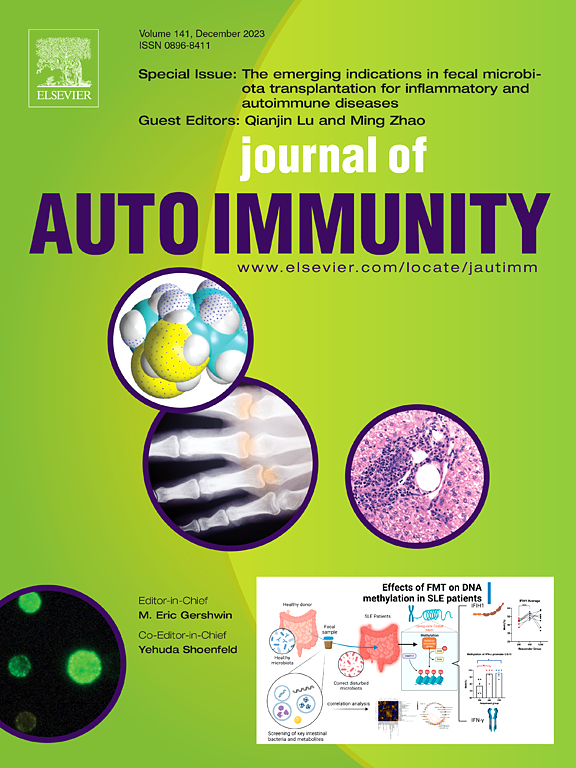HLA alleles predisposing to autoimmunity are linked to impaired immunoregulation in patients with juvenile autoimmune liver disease and in their first-degree relatives
IF 7
1区 医学
Q1 IMMUNOLOGY
引用次数: 0
Abstract
Background & aims
Juvenile autoimmune liver disease (JAILD) comprises autoimmune hepatitis and autoimmune sclerosing cholangitis. JAILD-predisposing genes include HLA-DR3,DR7, DR13 and haplotype A1-B8-DR3. Mechanisms leading to liver autoimmunity remain elusive, though JAILD patients have aberrated immunoregulation. We investigated the influence of HLA genes on immune cells, focusing on T-cells and frequency and function of T regulatory cells (Tregs) in JAILD patients, their first-degree-relatives (FDRs) and healthy controls (HCs).
Methods
HLA class I and II genotypes were defined by PCR and peripheral blood mononuclear cells were immunophenotyped by FACS in 82 patients, 72 FDRs, 50 HCs. Treg function was tested by inhibition of CD4posCD25neg T-cell proliferation. Links between HLA genes, Treg frequency/function, pro-inflammatory/immunoregulatory cytokines, soluble and membrane-bound programmed cell death-1 (PD-1) were investigated.
Results
Proportion of subjects carrying HLA DR3/DR7/DR13 was 88 %, 92 %, 64 % in patients, FDRs and HCs. Circulating Treg frequency was lower in patients and FDRs than HCs. Inhibitory capacity of Tregs was lower in patients but similar in FDRs compared to HCs. FDRs possessing HLA DR3/DR7/DR13 genes had Treg frequencies lower than those without. PD-1 posCD4pos T-cells were fewer in patients than HCs; PD-1posCD8pos T-cells were fewer in patients and FDRs than HCs. Patient plasma levels of IFN-γ were higher, and ratios of IFN-γ/IL-10 and IFN-γ/IL-2 lower than in HCs. All nine FDRs with autoimmune disorders had HLA DR3/DR7/DR13 genes and lower Treg frequency than those without autoimmune disorders and HCs.
Conclusion
We show a link between HLA disease-predisposing genes and defective immunoregulation not only in JAILD patients, but also in their FDRs, who are prone to autoimmune disorders.
易致自身免疫的HLA等位基因与幼年自身免疫性肝病患者及其一级亲属的免疫调节受损有关
背景,目的:青少年自身免疫性肝病(JAILD)包括自身免疫性肝炎和自身免疫性硬化性胆管炎。jaild易感基因包括HLA-DR3、DR7、DR13和A1-B8-DR3单倍型。导致肝脏自身免疫的机制仍然难以捉摸,尽管JAILD患者有异常的免疫调节。我们研究了HLA基因对免疫细胞的影响,重点是T细胞和T调节细胞(Tregs)的频率和功能,在狱卒患者,他们的一级亲属(fdr)和健康对照(hc)。方法对82例患者、72例fdr患者、50例hc患者进行外周血单核细胞免疫分型,并采用PCR方法对shlaⅰ类和ⅱ类基因型进行鉴定。通过抑制cd4poscd25阴性t细胞增殖来检测Treg功能。研究了HLA基因、Treg频率/功能、促炎/免疫调节细胞因子、可溶性和膜结合程序性细胞死亡-1 (PD-1)之间的联系。结果患者、fdr和hc中携带HLA DR3/DR7/DR13的比例分别为88%、92%和64%。患者和fdr的循环Treg频率低于hc。与hc相比,患者的Tregs抑制能力较低,但fdr的抑制能力相似。携带HLA DR3/DR7/DR13基因的fdr的Treg频率低于不携带的fdr。PD-1 posCD4pos t细胞在患者中少于hc;患者和fdr中PD-1posCD8pos t细胞少于hc。患者血浆中IFN-γ水平较高,IFN-γ/IL-10和IFN-γ/IL-2的比值低于hcc患者。所有患有自身免疫性疾病的9名fdr均有HLA DR3/DR7/DR13基因,Treg频率低于无自身免疫性疾病和hc的fdr。结论我们发现HLA易感基因与免疫调节缺陷之间的联系不仅存在于JAILD患者中,也存在于其易发生自身免疫性疾病的fdr中。
本文章由计算机程序翻译,如有差异,请以英文原文为准。
求助全文
约1分钟内获得全文
求助全文
来源期刊

Journal of autoimmunity
医学-免疫学
CiteScore
27.90
自引率
1.60%
发文量
117
审稿时长
17 days
期刊介绍:
The Journal of Autoimmunity serves as the primary publication for research on various facets of autoimmunity. These include topics such as the mechanism of self-recognition, regulation of autoimmune responses, experimental autoimmune diseases, diagnostic tests for autoantibodies, as well as the epidemiology, pathophysiology, and treatment of autoimmune diseases. While the journal covers a wide range of subjects, it emphasizes papers exploring the genetic, molecular biology, and cellular aspects of the field.
The Journal of Translational Autoimmunity, on the other hand, is a subsidiary journal of the Journal of Autoimmunity. It focuses specifically on translating scientific discoveries in autoimmunity into clinical applications and practical solutions. By highlighting research that bridges the gap between basic science and clinical practice, the Journal of Translational Autoimmunity aims to advance the understanding and treatment of autoimmune diseases.
 求助内容:
求助内容: 应助结果提醒方式:
应助结果提醒方式:


